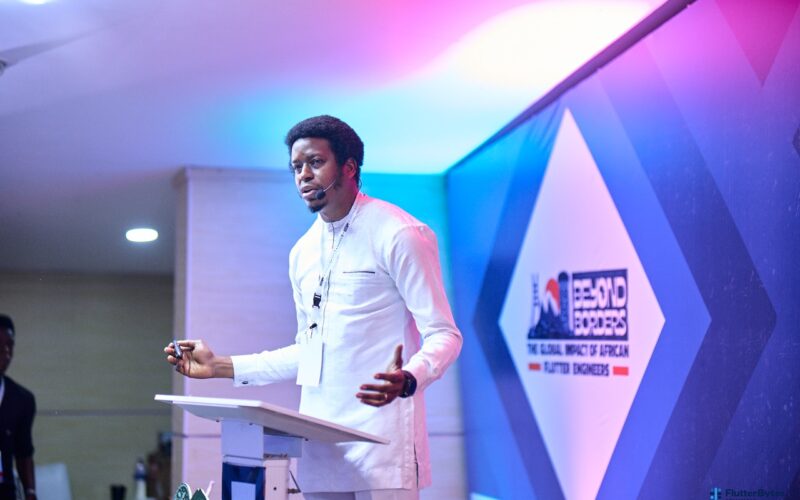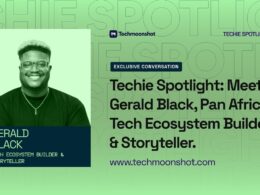Akin Afolabi is a skilled motion designer with a wealth of experience, having spent four to five years honing his craft in the creative industry. Based in the UK, Akin’s journey began in Nigeria, where he completed his education in Mass Communication at the prestigious University of Lagos (UNILAG). His academic background, coupled with his passion for visual storytelling, paved the way for his transition into motion design, where he now works full-time, bringing innovative ideas to life through dynamic visuals.
Akin’s work reflects his deep commitment to excellence, and his growing portfolio showcases the impact he’s making in the world of motion design. Whether working on commercial projects or personal passion pieces, Akin brings a fresh perspective, fusing his Nigerian background with global trends to create visually stunning content that resonates with audiences across different industries.
In this exclusive conversation, Akin Afolabi delves into his journey as a UK-based motion designer, sharing insights into how it all started back in Nigeria.
Can we get to know you?
Hello, my name is Akin Afolabi. I’m a UK-based motion designer originally from Nigeria, with about four to five years of full-time experience in this field. I graduated with a degree in Mass Communication from the University of Lagos (UNILAG). I’m the second-born and the first son in my family.
Tea or coffee? Which one gets you up and running in the morning?
Hot chocolate in the morning. Yeah, I don’t miss it, especially in recent times.
Can you share your journey into motion graphics design?
My journey into motion design actually started with graphic design—specifically, designing on my phone during my NYSC at a digital marketing company. I was the only digital marketer there, so along with marketing, I handled creating simple flyers and visuals on my phone.
I’ve always been drawn to motion graphics, even before I knew the term for it. Watching MTV Base, I was fascinated by the graphics in their ads and transitions between videos. It left a strong impression on me, and I kept thinking, I’d love to create something like this one day.
During NYSC, I began to get a feel for design, and I was introduced to a basic video software called Explaindio. It was quite limited, but it gave me my first taste of animation. However, after using it for a task, I forgot about it for a while—about two years, actually.
Then, in 2020, I stumbled upon the software again on my laptop. Out of curiosity, I opened it, and that sparked something. Within a month, I realized I needed better tools: a more powerful laptop and professional software. Through research, I discovered After Effects, but my current laptop couldn’t handle it. So, I saved up, got a new laptop, installed After Effects, and that was the real beginning of my journey into motion design, bringing me to where I am today.
Do you have any role models or mentors who influenced your career path?
Who influenced my career path? Honestly, no one initially, but as I got into the field, I found inspiration from some fantastic role models. Though I don’t know them personally, I follow their work closely. A few big influences include the community from School of Motion, which is pretty much essential for every up-and-coming motion designer. There are a lot of other inspiring artists I follow on Instagram, like Austin Bauwens, Callum Canarella, and Imsety. There’s also Fafa, Maestro Motion, and the founder of Ordinary Folk. Their work has influenced my style and growth in the field, even if from afar.
On a more personal level, I’m lucky to have close friends who are also motion designers. We’ve been growing together over the years, sharing resources, critiquing each other’s work, and supporting each other’s development. My friend Kef Williams and another close colleague Emma Abah have been particularly influential. Together, these people, directly and indirectly, have really shaped my journey in motion design.
Can you work us through your creative process from concept to final animation?
When it comes to personal projects, I start by drawing inspiration from something meaningful—whatever sparks an idea. Once I have that, I sketch out a few concepts. Then, I head to Pinterest to create a mood board, which helps me decide on the design or animation style I want to pursue. After that, I refine the design, start testing animations, and finally bring everything together with sound design to complete the piece.
For client projects, the process is similar but streamlined. Often, I receive a prepared design from the client, so my main focus is on the animation itself. I study the frames to understand the flow, transitions, and morphing effects. Then, I proceed with early test animations to see how everything works before moving on to the full animation. It’s a straightforward process, where I work within the existing design framework without adding anything extra.
What software or tools do you rely on most for your work?
I primarily work with After Effects, although I also use a bit of Cinema 4D and Redshift for certain effects. Since I’m mostly focused on two-dimensional design, After Effects is my main tool.
How do you undo creative blocks or periods when you are struggling to come up with new ideas?
When I hit a creative block on a personal project, I just set it aside for a while. I give myself a break—sometimes a week or so—where I don’t touch anything related to motion design. Instead, I focus on other things like watching movies, football, or just going out to clear my head. After some time, I’ll come back and try to add something small, just to see if it helps spark some ideas. Usually, that’s enough to get the creative flow going again.
But with a client project, it’s different—there’s a deadline, so there’s no option to wait out a creative block. I’ll just sit at my laptop and work through it, pushing forward until I find a solution.
What’s the most exciting, exciting project you’ve ever worked on?
I worked on a personal project last year called Welltech on Behance, and it really stands out as one of my most fulfilling pieces. It was well-received, which led to new job offers and clients. What made it particularly exciting was how it pushed my skills to new levels. Even though it was personal, I set some high technical goals for myself—techniques I hadn’t even tried before. Achieving those made it feel especially rewarding, beyond just the positive feedback and client interest.
What’s your favorite tech gadget?
My favorite tech gadgets are definitely my laptop and monitor. I’m not much of a gadget enthusiast—I just need the essentials, and I’m good. I don’t usually follow the latest specs, especially for Apple products like the MacBook Pro and such. I’m more familiar with basic Windows specs, but even then, I stick to what works for me: my laptop, mouse, and screen. That’s all I need.
If you were not into a motion graphics designer, what career do you think you’ll be in?
I’d probably still be in digital marketing, maybe at a more senior level—but still within the digital marketing field.
If you could give your younger self one piece of advice, what would that be?
I’d say try everything you can—explore various skills and paths. If you’re interested in something, like coding or digital design, give it a go. Even if you don’t pursue it to the end, the skills you learn can be valuable in whatever field you eventually settle in. All those experiences, whether they seem unrelated at the time, can help shape your perspective and enhance your work in the long run.
What are the common misconceptions people have about motion design that you find amusing?
One misconception I’ve encountered is the idea that motion design is something you can just quickly churn out. Some companies, especially in Nigeria, tend to expect a lot from motion designers. For instance, as an in-house motion designer at a FinTech company, they might expect you to produce three or four new, high-quality motion designs every week. It’s not just about video editing—it’s about creating fresh, raw, non-templated work under tight deadlines. While deadlines do matter in our field, motion design is a creative process that takes time. There’s a lot of work that goes into it, and it requires a clear understanding of the craft, which many businesses don’t fully grasp.
If you had to choose one color palette for the rest of your career, which colors would you choose?
That would be pale, orange, and gray.
If you could master instantly, any other tech skill, what would they be and why?
It would probably be software development. Interestingly, I got into motion design before I even considered exploring software development. However, motion design requires so much of my time and creative energy to master that I can’t fully dive into software development at the moment. Software development, like motion design, is a skill that demands complete focus—creative thinking and the ability to write code that works as intended. The idea of being able to write something and see it come to life is almost like a superpower to me, and that’s something I’d love to explore further in the future.
If you could design the motion graphics intro for any TV show past or present, which would it be?
As I mentioned, I used to watch MTV Base a lot. That inspired me to think, ‘Maybe I could create one of those spots for MTV Base.
What’s your favorite way to unwind after a busy week at work?
My favorite way to unwind is pretty simple. I love scrolling through TikTok, just watching videos and enjoying the content. I’m also a family person, so I spend a lot of time with my family. I don’t really go out much, so food is another big part of my relaxation—just enjoying good food with my family. So yeah, TikTok and food with loved ones are how I unwind.
Finally, can you share a book, podcast, or resources that have significantly influenced your career?
I don’t really read books much, and I’m not exactly a book person. I prefer other forms of content, like podcasts—though even the podcasts I listen to aren’t motion design-related, they’re more focused on music. But when it comes to resources for my work, YouTube is a goldmine for me. There are several channels that have really helped me develop my skills, such as Ravie, run by Austin Bauwens and his partners, Motion XP, Motion Circles, and Desmond Du. There’s also a guy named Hieu Vu, though I’m not sure how to pronounce his name. In terms of formal courses, School of Motion has been indispensable, especially their Animation Bootcamp and Advanced Motion Methods course. These resources have played a significant role in my growth.
It’s been a pleasure talking to you!
Thank you for having me! It’s a pleasure as well.













A really inspiring interview